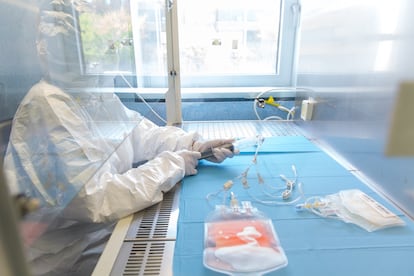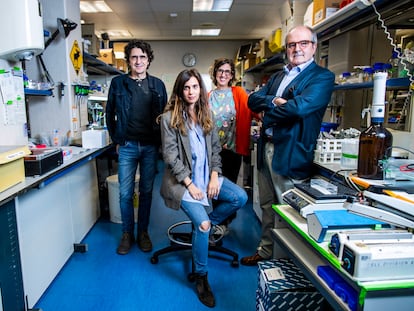Immunotherapy improves the prognosis of babies with a very aggressive leukemia
A trial with thirty patients under one year of age confirms that adding a bispecific antibody to the chemotherapy treatment increases the survival rates of a subtype of blood cancer from 66% to 93%

Childhood cancer is considered a very rare disease: only 155 new cases per year for every million children under 14 years of age. And while science is able to cure most cases, some tumors still prevail. Acute lymphoblastic leukemia, for example, is the most frequent pediatric cancer, and although 85% of patients overcome the disease, things get complicated in some subgroups, particularly among smaller babies with genetic alterations. Now, a new scientific study published this week in the New England Journal of Medicine, observes these tumors and shows hopeful results in improving the survival of babies that suffer from KMT2A gene-rearranged acute lymphoblastic leukemia, a very aggressive subtype of blood cancer: by adding immunotherapy to the usual chemotherapy treatment, the overall survival rates at two years went from 66% to 93%.
It is a first step in the right direction. Still, it is important to be cautious, says Susana Rives, head of the leukemia and lymphoma unit at the SJD Pediatric Cancer Center Barcelona, in Spain. “These are promising results compared to before, but this needs to be confirmed with more follow-up time,” says the hematologist, who did not participate in the study. The published data correspond to a phase II clinical trial carried out with thirty patients, all babies under 12 months of age, and with a follow-up of a couple of years. However, although the findings will have to be consolidated, these first results are so encouraging that the authors hope to be able to incorporate this new therapeutic strategy as a first-line treatment among these patients.
In absolute numbers, the babies with this subtype of acute lymphoblastic leukemia (ALL) are few. If tumors in children are already infrequent, they are even more so in babies under one year; “a rare among the rare,” agrees pediatrician Pablo Velasco from the pediatric oncology and hematology service of the Vall d’Hebron hospital in Barcelona. The genetic alteration, however, is more frequent in babies with ALL than in older children: “80% of children under one year with ALL have this genetic rearrangement [of the KMT2A gene], which goes hand in hand with the bad prognosis. We have not found more effective therapies,” laments the pediatrician, who did not participate in this research either, but celebrates its “spectacular results.”
The current therapeutic protocol to treat KMT2A-rearranged ALL in infants under one year of age includes two years of intensive chemotherapy and, in some cases, a bone marrow transplant. However, the global results are not very favorable: the rate of complication-free survival at three years is less than 40%, the authors point out in the article. “It is a very aggressive disease, more resistant to standard chemotherapy. Intensive chemotherapy works very well for half of the babies. But in the other half, the disease returns within two years, or the children die from it, or sometimes from side effects of therapy. 90% of relapses occur during the course of the two years of therapy,” explains Inge van der Sluis, a pediatric oncologist and clinical pharmacologist at the Princess Máxima Center for Pediatric Oncology in Utrecht, Netherlands, and lead author of the study.
Although the approach to ALL in adults and older children has improved in recent decades, the case of babies has lagged further behind in the search for therapies with better results. The highly aggressive nature of KMT2A-rearranged ALL makes relapses very frequent (two-thirds of recurrences actually happen in the first year after diagnosis, even when fully treated), and the prognosis worsens; up to now, explains van der Sluis, survival after relapse was only 20%.
Faced with this grim scenario, the authors of the study decided to try immunotherapy, which consists activating the body’s own immune system with drugs so it kills the malignant cells. They chose immunotherapy because chemotherapy intensification was not working, and further intensification was impossible due to its toxicity. The drug they used was blinatumomab; it had already been studied in adults and older children with ALL, but it was not yet clear if it was well tolerated and effective in infants, says the Dutch doctor.
Living longer and better
Blinatumomab is a bispecific antibody that works like a sort of plug adapter, explains Rives: on one end it binds to the tumor cell and on the other to the T lymphocytes, which are in charge of destroying the malignant cells. Then it introduces them, so that the lymphocyte recognizes, attacks and destroys those leukemia cells. The researchers, who added the immunotherapy to the usual treatment, observed the patients for two years and compared their progress with data from previous studies that had only treated the children with chemotherapy.
“We found that adding blinatumomab to standard chemotherapy leads to a significant improvement in survival for babies with KMT2A-rearranged acute lymphoblastic leukemia: their chance of survival increased from 66% to 93%. And the chance that their cancer would return or that they would die from the disease was greatly reduced, from 51% to 18%,” summarizes van der Sluis. In other words, they live longer and with a better quality of life.
The short-term harmful effects of this new therapeutic approach have also been “manageable,” according to the experts consulted. Not only that, but there actually was less collateral damage than with just chemotherapy, notes van der Sluis: “Potential side effects included fever, anemia or infection, but they were handled well.”
Rives celebrates what she considers to be the two great advantages that this study yields: “It improves results and prevents early relapses. And the toxicity that these children have presented is lower than with the intensive chemotherapy blocks, which is what they receive now. In the short term, it is not toxic. We’ll see what happens in the long term,” she points out.
The Dutch researcher explains that “the follow-up was relatively short [about 26 months], but it covers the period in which most recurrences would be expected.” It is in that two-year period when relapses usually occur, and if the results improve in that critical window, that period is already valuable, agrees Rives. However, van der Sluis notes that future relapses cannot be ruled out, adding that “a longer follow-up is expected.”
All the experts consulted agree that it will take more time and studies to consolidate the data. The limitations of the study itself reflect the short follow-up time and the fact that it is not a randomized study (with a control group that does not receive immunotherapy to assess the real impact); still, the authors hope that these results will be enough to change the standard treatment for a cancer with such a poor prognosis. “As a result of our study, all the babies with KMT2A-rearranged ALL will receive immunotherapy as part of the standard treatment,” says van der Sluis. However, at the moment patients can only receive treatment within the study protocols in order to gain access to blinatumomab. A larger study with 160 patients from 27 countries is already in the planning stages.
Further follow-up
The experts acknowledge that this is a study with few patients that were observed for a short time; being such a rare disease, they explain, it is difficult to increase the number of participants. Velasco assures that, in any case, the study published in the New England Journal of Medicine is already “good news” and opens the doors to “an interesting future.” Now, future trials will help answer the questions that remain in the air. “We know that relapses occur particularly at the beginning. But, is immunotherapy going to change the relapse profile? We don’t know. We will have to follow up,” he says.
Currently, it is unknown what happens to these babies after the age of two, if the disease returns or if any new side effects appear. However, the results are “encouraging,” insists Pablo Menéndez, main researcher of the stem cell biology, developmental leukemia and immunotherapy group at the Josep Carreras Leukemia Research Institute, in Spain. “The research of many years is beginning to yield results in childhood cancer. It is important to be cautious and observe them for years, but these are not mice – they are patients, and with an approved and marketed drug,” he celebrates.
Sign up for our weekly newsletter to get more English-language news coverage from EL PAÍS USA Edition
Tu suscripción se está usando en otro dispositivo
¿Quieres añadir otro usuario a tu suscripción?
Si continúas leyendo en este dispositivo, no se podrá leer en el otro.
FlechaTu suscripción se está usando en otro dispositivo y solo puedes acceder a EL PAÍS desde un dispositivo a la vez.
Si quieres compartir tu cuenta, cambia tu suscripción a la modalidad Premium, así podrás añadir otro usuario. Cada uno accederá con su propia cuenta de email, lo que os permitirá personalizar vuestra experiencia en EL PAÍS.
¿Tienes una suscripción de empresa? Accede aquí para contratar más cuentas.
En el caso de no saber quién está usando tu cuenta, te recomendamos cambiar tu contraseña aquí.
Si decides continuar compartiendo tu cuenta, este mensaje se mostrará en tu dispositivo y en el de la otra persona que está usando tu cuenta de forma indefinida, afectando a tu experiencia de lectura. Puedes consultar aquí los términos y condiciones de la suscripción digital.
More information
Archived In
Últimas noticias
Most viewed
- Reinhard Genzel, Nobel laureate in physics: ‘One-minute videos will never give you the truth’
- Pablo Escobar’s hippos: A serious environmental problem, 40 years on
- Charles Dubouloz, mountaineering star, retires at 36 with a farewell tour inspired by Walter Bonatti
- Why we lost the habit of sleeping in two segments and how that changed our sense of time
- The Florida Keys tourist paradise is besieged by immigration agents: ‘We’ve never seen anything like this’











































